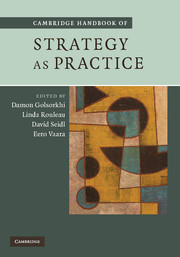Book contents
- Frontmatter
- Contents
- List of figures
- List of tables
- List of contributors
- Introduction: What is Strategy as Practice?
- PART I ONTOLOGICAL AND EPISTEMOLOGICAL QUESTIONS
- PART II THEORETICAL DIRECTIONS
- 7 Giddens, structuration theory and Strategy as Practice
- 8 An activity-theory approach to Strategy as Practice
- 9 A Bourdieusian perspective on strategizing
- 10 A Wittgensteinian perspective on strategizing
- 11 A Foucauldian perspective on strategic practice: strategy as the art of (un)folding
- 12 A narrative approach to Strategy as Practice: strategy making from texts and narratives
- PART III METHODOLOGICAL TRACKS
- PART IV APPLICATION VARIATIONS
- Author Index
- Index
- References
12 - A narrative approach to Strategy as Practice: strategy making from texts and narratives
Published online by Cambridge University Press: 05 October 2012
- Frontmatter
- Contents
- List of figures
- List of tables
- List of contributors
- Introduction: What is Strategy as Practice?
- PART I ONTOLOGICAL AND EPISTEMOLOGICAL QUESTIONS
- PART II THEORETICAL DIRECTIONS
- 7 Giddens, structuration theory and Strategy as Practice
- 8 An activity-theory approach to Strategy as Practice
- 9 A Bourdieusian perspective on strategizing
- 10 A Wittgensteinian perspective on strategizing
- 11 A Foucauldian perspective on strategic practice: strategy as the art of (un)folding
- 12 A narrative approach to Strategy as Practice: strategy making from texts and narratives
- PART III METHODOLOGICAL TRACKS
- PART IV APPLICATION VARIATIONS
- Author Index
- Index
- References
Summary
The narrativizing of practices is a textual ‘way of operating’, having its own procedures and tactics. […] Shouldn't we recognize its scientific legitimacy by assuming that instead of being a remainder that cannot be, or has not yet been, eliminated from discourse, narrativity has a necessary function in it, and that a theory of narration is indissociable from a theory of practices, as its condition as well as its production. (de Certeau 1988: 78)
Introduction
The Strategy as Practice approach requires a close and detailed scrutiny of practitioners' activities. Such a micro-level approach enables us to depart from the conventional perspective and delve into the ‘internal life of the process’, to study in more details ‘individual’ rather than ‘organizational’ performance (Samra-Fredericks 2003). Moving attention away from macro-processes towards various aspects of the minutiae of strategy making has changed the discourse used by researchers to explain how strategy is conceived, explained and communicated (Whittington 2007). In practice, strategy is still essentially considered as micro-processes – i.e. the actual activities carried out by individuals within their organized contexts.
Although social practice theory tends to emphasize the tacit and informal dimensions of practices and praxis, Strategy as Practice research has focused much more on explicit practices, especially on operating procedures and standards (Jarzabkowski 2004, 2005), norms of appropriate strategic behaviour set by industry recipes (Spender 1989) and legitimizing discourses (Barry and Elmes 1997).
- Type
- Chapter
- Information
- Cambridge Handbook of Strategy as Practice , pp. 183 - 198Publisher: Cambridge University PressPrint publication year: 2010
References
- 13
- Cited by



